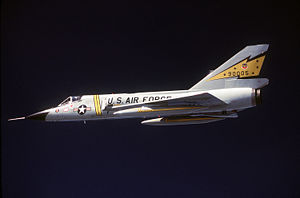Convair F-106
| F-106 Delta Dart | |
|---|---|
 |
|
| Convair F-106A Delta Dart of the 5th Fighter Interceptor Squadron | |
| Role | Interceptor |
| Manufacturer | Convair |
| First flight | 26 December 1956 |
| Introduction | June 1959 |
| Retired | August 1988 (ANG); 1998 (NASA) |
| Primary users |
United States Air Force Air National Guard |
| Number built | 342 (2 prototypes, 277 F-106A, 63 F-106B) |
| Unit cost |
US$4.7 million (1973)
$25.1 million (2014) |
| Developed from | Convair F-102 Delta Dagger |
The Convair F-106 Delta Dart was the primary all-weather interceptor aircraft of the United States Air Force from the 1960s through the 1980s. Designed as the so-called "Ultimate Interceptor", it proved to be the last dedicated interceptor in U.S. Air Force service to date. It was gradually retired during the 1980s, with the QF-106 drone conversions of the aircraft being used until 1998 under the Pacer Six Program.
The F-106 was the ultimate development of the USAF's 1954 interceptor program of the early 1950s. The initial winner of this competition had been the F-102 Delta Dagger, but early versions of this aircraft had demonstrated extremely poor performance, limited to subsonic speeds and relatively low altitudes. During the testing program the F-102 underwent numerous changes to improve its performance, notably the application of the area rule to the fuselage shaping and a change of engine, and the dropping of the advanced MX-1179 fire control system and its replacement with a slightly upgraded version of the MX-1 already in use on subsonic designs. The resulting aircraft became the F-102A, and in spite of being considered barely suitable for its mission, the Air Force sent out a production contract in March 1954, with the first deliveries expected the next year.
By December 1951 the Air Force had already turned its attention to a further improved version, the F-102B. Initially the main planned change was the replacement of the A-model's Pratt & Whitney J57 (itself replacing the original J40) with the more powerful Bristol Olympus, produced under license as the Wright J67. By the time this would be available, the MX-1179 was expected to be available, and was selected as well. The result would be the "ultimate interceptor" the Air Force wanted originally. However, while initial work on the Olympus appeared to go well, by August 1953 Wright was already a full year behind schedule in development. Continued development did not improve issues, and in early 1955 the Air Force approved the switch to the Pratt & Whitney J75.
...
Wikipedia
